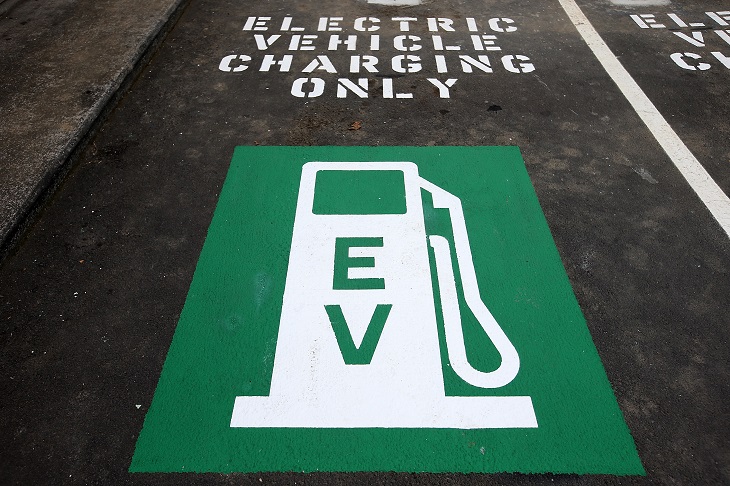Countries are keen to out-virtue-signal each other with electric cars and their contribution to reducing Climate Change; what is plainly missing in the game is any concept as to how these goals can realistically be achieved.
Following the Parliament’s recent confirmation of the 43 per cent CO2 reduction target by 2030 and zero by 2050, the pressure is on.
California, Woke capital of the world, leads the pack as the home of over one-third of America’s electric cars. It has targeted new car sales of 35 per cent electric by 2026, 68 per cent by 2030 (compared with a predicted American figure of 10 per cent at that time), and 100 per cent by 2035.
There are consequences. There are already electricity shortages in the pro-renewables state and users have been asked not to charge their cars between 3 and 9 pm when there is a 30 per cent increase in home use of electricity and the sun is low (or set).
California is fortunate that it has energy backup provided by a nuclear power station (which was due to be closed), and out-of-state fossil fuel generation. The Democrats, under sleepy Joe, want to introduce country-wide targets of 50 per cent EV sales by 2030, the UK has an even less achievable target of 80 per cent by 2030.
In Australia, similar problems may be afoot. A spoof flyer sent out to Greens-run Brighton Council in Melbourne asked homeowners to restrict their electricity use so that car owners can charge their vehicles. The joke may become reality as other Greens councils in Sydney look at future bans on petrol/diesel vehicles entering their areas, placing upward pressure on a failing grid. Last year there were 26,000 EVs purchased, 3 per cent of the total.
Future predictions are that new electric vehicle (EV) global sales, currently at around 10 per cent, will reach 23 per cent in China and 40 per cent in Europe by 2025.
The French government is putting pressure on conventional vehicle sales by introducing bans on non-EV entering cities. Legislation has been passed and will become active in January 2023. Green City Councils in this country are likely to follow this virtue signalling.
Australian government predictions are that by 2030, 89 per cent of new sales will be EV; the availability of electricity to charge them is another matter.
The first problem to be addressed is the increased price of the vehicle; costing between $5,000 and $20,000 more than a petrol-driven car, unsurprisingly, more subsidies may be necessary. Despite cheaper vehicle servicing, it is estimated it will take 10 years to recoup this extra cost. These vehicles will not be charged road excise duty on fuel sales, this will result in significant income loss (currently over $19 billion) to the road network maintenance, which others may have to subsidise; the Federal government is looking at taxing vehicles on the distance driven. A similar scheme has already been considered in Victoria, at 2.6 cents per kilometre, NSW will activate a scheme in 2027, at 2.5 cents per kilometre.
There are a multitude of other problems to be overcome to achieve this transporting Nirvana. These programs require an enormous number of batteries, where will they come from? The auto manufacturers are making this switch, as well as for car production, but this takes time and there are significant supply chain issues, with most batteries coming from China. A recent estimate was that 83 per cent of electric vehicles, under the names of Tesla, MG, Volvo, and BM, come from China. There are plans to build US battery manufacturing capacity, in addition to Tesla, involving VW, Toyota, and Ford.
Forecasts suggest that the price of graphite, nickel, and lithium will increase between 8 and 11-fold in the next decade; batteries also require copper, cobalt, manganese, and rare earths, and predictions are that demand will exceed supply. The price of battery raw materials has already increased by 144 per cent in the last 2 years. Lithium reserves are estimated at 8 million tons in Chile, 2.5 million tons in Australia, 2 million tons in Argentina, and 1 million tons in China; two-thirds of the world’s cobalt resources are in the Congo, where child labour is involved.
The pollution produced by mining and processing lithium and rare earths needs to be added into the environmental equation. Currently, batteries are not recyclable and will add to pollution, but there are plans to recycle as many as 30 per cent; even if this goal is achievable, there will still be pollution caused by leaking of the toxic substances they contain, as well as the environmental pollution resulting from increased mining activity.
American estimates are that a typical EV battery weighs around 1,000 pounds (approximately half that in kilos): it contains 25 pounds of lithium, sixty pounds of nickel, 44 pounds of manganese, 30 pounds of cobalt, 200 pounds of copper, and 400 pounds of aluminium, steel, and plastic. A new battery lasts for around 5 to 8 years, before replacement; most will be covered by warranty for the new battery, but the cost of fitting a replacement varies between $5,000 and $20,000, depending on the vehicle. An unintended consequence of this extra weight is the delivery of vehicles by transporters, with weight limits meaning they can transport fewer vehicles, an extra cost.
Next up is the concept of charging. Where and how will the huge increase in electricity demand, estimated at the equivalent of 50 domestic fridges per charge, (an average of 30KWh), be met? Those countries and areas relying on renewable energy are already struggling to cope with current demand, what will the future bring? Current UK figures give a cost of slow 30-amp recharge at home, using standard AC, this takes between 7 and 20 hours to full charge, at 34p per kWh (58c); this is before addressing the practical matter of charging a vehicle when there is no garage and it is parked on the street.
The home fast-charging unit costs between $1,000 to $1,500 plus installation in Australia, it can achieve a 350-amp recharge; costs increase with the speed of charging. The quickest, at around $1.15) per kWh is an ultrarapid charger, this takes 10-15 minutes on average, assuming the battery can handle this charge; there have been numerous examples of the ultra-rapid charge causing fires.
Assuming that these charging options are available, the typical 400k battery range is reduced by up to 18 per cent when charging in cold weather, when towing, or when using power for the A/C or radio. A new prototype, a solid-state lithium battery, under development in America, claims a recharge time of 3 minutes; it is unlikely to be commercially available for 5 years.
The time taken to charge has to be compared with the average time at a petrol station, with its ability to service 2,000-plus vehicles a day. In the future there may be recharge options in petrol stations, cinemas, supermarkets, etc. Long-distance travel remains limited in Australia until charging stations are established, perhaps with yet more subsidies. A start has been made in NSW, with 230 free charge stations installed by 2025, mainly in cities, and 1,000 by 10 years; WA plans to install fast chargers at 49 remote spots (cost $43 million), NRMA is also rolling out chargers. This is a long way from the estimated 30,000 needed, and the queues they will inevitably generate.
Projections are that 35 per cent of all new Australian vehicles will be electric by 2036, with a 7 TWh (I Terawatt is a million megawatts) increase in demand, 60 per cent will be electric by 2050; if we plan to ultimately have 12 million electric vehicles the demand will skyrocket to an estimated 45 TWh by 2050; this compares with current Australian total usage of 93 TWh, which is also rising. The John Deere Tractor company is promoting electric vehicles to work the fields – a long way from any recharge. Even the army is being pushed to trial electric vehicles with an electric Bushmaster armoured vehicle in development – it’s lighter and quieter, but doesn’t go very far – only 200km, and there are no charging stations in the battlefields! Electric planes and ships, such as the yet-to-be-built ‘Ecoship’, are even more conjecture for the next decade.
Where will this huge increase in electricity supply come from, as we prematurely shut down baseload power generation; renewables currently contribute less than 20 per cent of demand? The new Labor government is walking both sides of the street and keeping quiet about new coal and gas exploration approvals. The stampede to shut down coal-fired generation continues, leaving a huge supply gap. Replacing 6 coal-fired and 4 gas power stations, with hydro-power, is the latest pipe dream from the Queensland government. This newly announced project will apparently be completed by 2035 at a cost of $12 billion-plus infrastructure; this is before even putting up a plan, never mind the inevitable environmental and sacred site clearances. The example of Snowy Hydro 2, with big budget over-runs, environmental destruction, and lengthy delays, does not inspire. What is often forgotten in the media hype, is that these hydro plants do not make electricity, they merely store it.
The manufacture of solar panels also requires a vast array of highly toxic chemicals. Apart from the environmental destruction windmills are no better, American figures show each one weighs around 1,700 tons, and contains 1,300 tons of concrete, 260 tons of steel 48 tons of iron, 24 tons of fiberglass, plus rare earths neodymium, praseodymium, and dysprosium. As neither panels, nor blades are recyclable, is this really the environmentally-friendly renewable alternative it is portrayed as?
Hydrogen is another much-touted energy solution, despite more subsidies it is years away from contributing to the grid, and the economics of its use for energy storage are far from solved. Ultimately, it may also provide some competition for powering standard vehicles, as well as for trucks and buses. Two Japanese companies are exploring the use of hydrogen fuel-celled batteries and hydrogen combustion engines. Another novel approach is the use of direct solar power from panels on the vehicle, as in the World Solar Challenge, over 3,000 kilometres in Australia, technology is improving.
In world terms, the expenditure of $55 trillion on renewables over the last 2 decades has reduced dependence on fossil fuels from 86 per cent to 84 per cent. No matter what ideology is followed, it is not possible to get to zero emissions by 2050. At enormous cost, we are cutting out cheap, reliable, electricity generation, with little effect on Global CO2 levels; the next generation energy supply will produce its own environmental pollution – and what happens to all the old cars?
The precipitous rush to renewables has resulted in looming energy shortages in Europe, as a long winter is ahead; it will be interesting to see how they walk back their agenda at the next COP talkfest in Egypt in November. It is time we accepted the reality and added nuclear power to the mix.
Got something to add? Join the discussion and comment below.
Get 10 issues for just $10
Subscribe to The Spectator Australia today for the next 10 magazine issues, plus full online access, for just $10.


























Comments
Don't miss out
Join the conversation with other Spectator Australia readers. Subscribe to leave a comment.
SUBSCRIBEAlready a subscriber? Log in